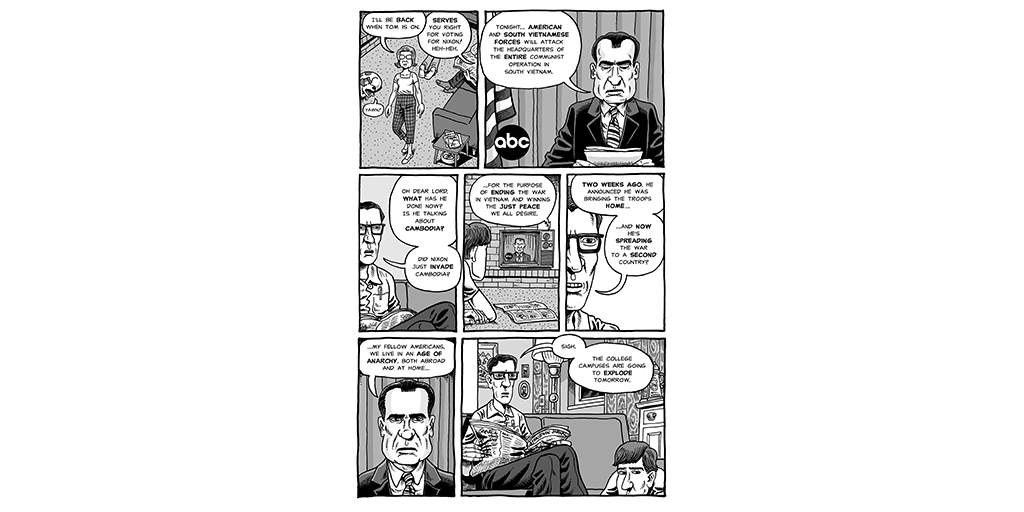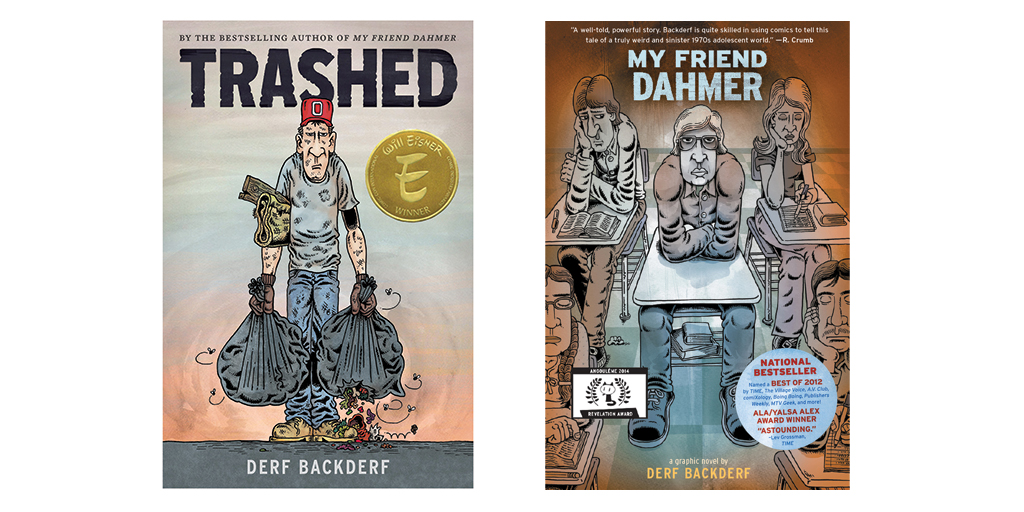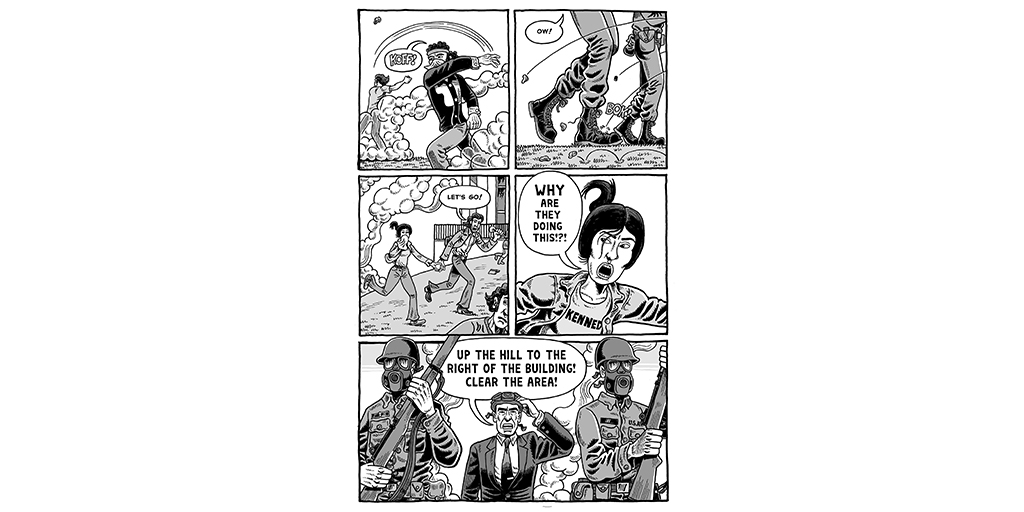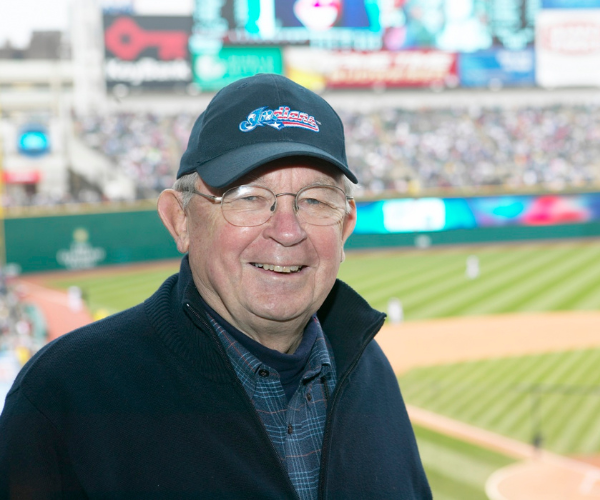The Lines Between Hope and Struggle
by Sheehan Hannan | Apr. 29, 2020 | 12:00 PM

PHOTOGRAPHED BY ALAIN SEUX
When we first met in January, Derf and I, we couldn’t have known how our world would change. Everything was normal then. The streets of Shaker Heights, where Derf lives, were mostly devoid of cars or humans. But that was no symptom of quarantine. It was just a weekday. As I pulled up to his house, I even saw someone walking their dog. Derf greeted me at the front door. We shook hands.
I had come to interview Derf about his new graphic novel, Kent State: Four Dead In Ohio. In it, the events of the May 4, 1970, Kent State University shootings, which took place 50 years ago this month, are reproduced in vivid and carefully researched detail.
The Kent State shootings are an odd topic for Derf, who got his start drawing lefty political cartoons, made his name with the irreverent, sometimes profane alt weekly comic strip The City and then pivoted into the world of graphic novels with his debut Punk Rock & Trailer Parks, a coming-of-age story of sex, punk rock and rebellion.
To be fair, his breakthrough works have struck a more serious tone. Most people know Derf for My Friend Dahmer, the tragic tale of his high school semi-friendship with the serial killer Jeffrey Dahmer. Other people know him from Trashed, his specifically fictional but broadly true story about garbage collectors and the tons of trash we all inflict upon the Earth.
Kent State, I was reminded as we climbed the stairs and sat down in Derf’s cubbyhole attic office, is his most serious journalistic work to date. Dahmer was based on his and his friends’ personal experiences, and research on Dahmer. Trashed intermingled a fictionalized version of the year he spent collecting waste, back when he was plain John Backderf, with deep reporting on the trash industry. But Kent State is something apart.
In Derf’s studio, a drawing board sat in the room’s center. Scattered stacks of books and files of paper seemed to take up most of the other surfaces around it, forming a peculiar interior decoration scheme of primary source documents, reference photos, articles and live sketches.
Derf conducted that research to faithfully tell the stories of the four students who were killed by the National Guard on Kent State’s campus. Those stories are touching and horrifying, a reminder of the domestic costs of forever wars, the human cost of dissent and the consequences of placing state powers in the hands of what Derf sees as idiots, ideologues and warmongers.
Kent State is also Derf at his most assured. He is 60 now, and though his wry powers of observation and idiosyncratic style are no less present, Kent State reflects a sober side.
That day in his office, Derf and I made plans to visit the campus of Kent State together. But I was feeling a pain in my side, which in subsequent days got worse and turned into three days in the hospital, a week at home on drugs and the promise of future surgery. I canceled and Derf jetted off to France for a few weeks, where he has a large and loyal readership.
Then on March 18, in the midst of the coronavirus shutdown, Derf emailed. The publication of Kent State was pushed back to September, when he hoped at least some normalcy will return. Preorders were still available. “It’s all a strange new world,” Derf said when I called. “It would be horrible to put out a book now, just as the entire book retail machinery is grinding to a stop. This is the best of bad options.”
My first thought was, Oh crap. My second was, How appropriate. All of Derf’s graphic novels wrestle with bad options and doom: Dahmer’s early years, mountains of trash, tragic shootings. Even the comparatively joyous Punk Rock & Trailer Parks presents a world arrayed against Otto, its protagonist.
But for all fabric of gloom that clothes them, Derf’s stories are also embroidered with threads of hope and struggle, small reminders of the good in the big, bad world: Otto finding a sense of belonging in an Akron punk club; J.B. the trash man marveling at his crazy coworkers; a Kent student placing a flower in a guardsman’s gun barrel.
It turns out that when actual doom arrives, we need an artist like Derf Backderf, a Clevelander, to remind us that though awfulness is enduring, so are we.
“I think that’s probably a little bit [from] growing up in the Rust Belt. We’ve been screwed so many times by Wall Street, government or whoever that we have to make the best of it,” Derf told me as we sat together in his office. “That’s that attitude, kind of like, To hell with the rest of you, I’m going to make the most of the what’s here.”

We did make that visit to Kent.
It was a freezing-cold February day, and Derf and I met up at Scribbles, a quaint locally owned spot across the street from a pair of grain silos. Derf ordered a latte and we took a table in a corner. Sitting sideways in the chair and leaning his tall frame against the wall, he slowly drained the drink as we talked. He came here, he said, to unwind on research trips.
We touched on many things: his status as the “old man” of Cleveland comics, his alt weekly strip and political cartoons, his midcareer turn to graphic novels. We also, of course, talked about Kent State.
Most Clevelanders are familiar with the general outlines of the May 4 story. They reverberated so deafeningly through history that it is difficult not to. National Guardsman, who had been summoned to campus to put down unrest sparked by the American invasion of Cambodia, fired into a crowd of unarmed students.
But fewer know the specifics, or the stories of the young people who were shot: New Yorker Jeff Miller, Clevelander Allison Krause, Lorain High School graduate Bill Schroeder and Youngstown native Sandy Scheuer. With the book, Derf seeks to remedy that. The story follows Miller, Krause, Schroeder and Scheuer, and an anonymous National Guardsman Derf renamed Karlovic, through the tumultuous weekend of May 1-4, ending with the fateful shooting.
But there is also a hidden story in Kent State: a Derf origin story.
In the opening pages, Derf is 10 years old on April 30, 1970, clutching a MAD magazine in the passenger seat of his mom’s car. She drives along a road lined with National Guard soldiers, whose bayonets are fixed, ready to put down a wildcat Teamsters strike.
“My parents whisper, when they think I’m out of earshot, that the country is tearing itself apart,” he writes. “But these things are abstractions to me. They don’t affect my life. All that changes when the National Guard rolls into my sleepy hometown.”
That night at home, Derf lays on the floor of the living room as Nixon comes on TV. In an infamous address, Nixon declares that, “we live in an age of anarchy, both abroad and at home.” American forces will invade Cambodia, he says, expanding the scope of the Vietnam War. “The college campuses are going to explode tomorrow,” says Derf’s father. Derf watches from the floor with his comic book, silently.
Looking back on it now, Derf saw that moment as quietly transformative. “It was Kent State that sparked an intellectual curiosity. I started paying more attention to news and current events,” Derf tells me. “That led to becoming a high school journalist, that led to being a journalism major, that led to being a political cartoonist. It all is connected.”
From about the turn of the century, the Backderf men had all worked for Akron rubber companies. Derf’s great-grandfather was one of the first employees at Firestone Tire & Rubber Co., his grandfather worked for BFGoodrich for 45 years and his father toiled there too, as a chemist. His mother raised Derf and his brother, and then worked as a secretary. Derf recalls a typical, though not rigid, suburban upbringing in Richfield; his parents used to dress the family for church, drop the kids at Sunday school and then secretly skip service to get doughnuts.
“It was happy at times. There were parts of it that weren’t happy. Not my family. My family was always fine. But s--- happening at school or being tortured by older kids,” says Derf. “I was bored. But it was OK.”
Derf was drawing from the time he could grasp a pencil. As he grew up, he paged through MAD magazine and Warren Publishing magazines such as Vampirella and Creepy. Later, after college, he read the influential strips of Lynda Barry.
But the primary influence on him were the underground comics of Spain Rodriguez. A Buffalo, New York, native, Rodriguez was a socialist who rode in a biker gang and drew class consciousness warrior characters such as Trashman and Big Bitch. His characters’ nipples poked out, their knuckles were like crags and their guns rat-a-tat-ed. For a 1970s latchkey kid in the Akron suburbs, Rodriguez offered a testosterone jolt of sex, violence and revolutionary politics.
After attending Revere High School, Derf went to the Art Institute of Pittsburgh, a trade school. He had hoped it would open up the world of comics. It did not. He found the experience of illustrating engine parts dull, and returned home, where he worked for a year in Richfield as a garbage collector. Then he enrolled in the journalism program at Ohio State University, hoping to one day snag a job as an editorial cartoonist.
One of his teachers, Lucy Shelton Caswell, recalled that Derf (she still calls him John), arrived in her newspaper cartoons class at OSU with a well-developed knowledge of the form, and even of its early-1900s greats. “It was fun because Winsor McCay wasn’t an unknown to him. George Herriman wasn’t an unknown,” says Caswell. “It’s possible to do a much deeper kind of teaching if students bring some knowledge already to the course.”
It was also a fortuitous moment for a journeyman cartoonist at OSU, where a vibrant comics culture was blossoming. In 1977, in two converted classrooms, Caswell began organizing a collection of donated materials from the cartoonist and Hillsboro native Milton Caniff. That collection was the catalyst for the Billy Ireland Cartoon Library & Museum, perhaps the most preeminent cartoon collection in the United States.
Contained within the Billy Ireland collection are Derf’s first attempts at political cartoons. Pages from a sketchbook dated 1979 shows a young creator wobbling on uncertain sea legs. His characters, like a big-lipped Jimmy Carter, are mostly true to life, with only slightly exaggerated features. But his sensibility was already sharp. One cartoon commented on that year’s oil shock with a ship, “the U.S.S. Auto Co.,” sinking Titanic-style into the waves. “It’s no good, we’re still going down,” the caption reads. “Throw out some more auto workers.”
It took Derf three tries to get on the staff of The Lantern, the campus newspaper. He finally did in spring 1981, with a portfolio of cartoons that mocked Carter and Ronald Reagan alike. He wrote stories and kept drawing irreverent, confrontational cartoons, like one commenting on the gambling addiction of Buckeye quarterback Art Schlichter. The image of an OSU football player getting fitted for cement shoes prompted enough of an uproar on campus that Derf figured it wise to skip town for a few days.
“You gotta look back and think, Well I had some chutzpah,” says Derf. “Maybe not many brains, but chutzpah.”

Derf had barely gotten a job as a professional cartoonist before he got fired.
After college, he worked for The Evening Times in West Palm Beach, Florida, earning the kingly sum of $18,000 a year. His drawings from then were stylistically refined versions of his college work: a tank with a smiley face shooting out of its barrel (subtitle: “American foreign policy”), Jerry Falwell in blackface speaking in South Africa, or a dolphin wearing a football helmet resting on a plate, symbolizing the local football team having been eaten for lunch. “I was so young, 22, 23,” says Derf. “I had no business writing political cartoons at that age.”
But as he experimented, Derf was also discovering that the strait-laced world of corporate media wasn’t really his thing. As the paper was reorganizing as The Palm Beach Post, an editor fired him for “general tastelessness.” “My attitude back then was, Screw you buddy,” says Derf. The paper’s new editors hired him back the next day.
After amassing a portfolio of work, he was hired by The Plain Dealer in 1986. But that didn’t last long either. “Honestly, I got tired of being told what to draw and tired of doing lame cartoons for squares,” says Derf. “I had these comics in my head [and] I wanted to see if I could get them out of my head onto paper. So I quit.”
In 1989, he began to develop his own syndicated strips and pushed toward a signature style. He pitched a strip about a container of leftovers festering in the fridge for so long it gained sentience. (The Universal Press syndicate rejected it. In another version, the leftovers steal the protagonist’s girlfriend.) He was also experimenting, drawing dada, full-color character studies: a man playing keyboard, his cylindrical head consisting mostly of a Pez dispenser-like nose and a tiny mouth, or a barbarian blonde woman, all bulging neck and square head, dragging a man across the desert with tiny hands.
At the same time, he was developing The City, a strip drawn in that new, post-punk dada style. He came up with the idea while sketching on an Amtrak train, drawing what he had seen on a trip to New York: Madeline Kahn at a play, his own feet jumping gleefully on the John Lennon memorial in Central Park, a bum passed out face-first in a Penn Station bathroom garbage can.
Later, he also drew strips set in Cleveland, such as panels of an old lady cursing out her mute, cigar-chomping husband in an otherwise silent laundromat, or a Little Italy baker talking about “th’ boyz” from the neighborhood who beat up “some black kids” who “should know better, riding’ their bikes through here.” In 1990, he sold his first one to the scrappy alt weekly Cleveland Edition.
But alt weekly cartooning doesn’t always pay the bills, and Derf found a day job as an illustrator at the Akron Beacon Journal. At the time, the paper was fostering a class of excellent journalists and writers, among them Thrity Umrigar, David Giffels, Steve Love, Regina Brett, Bob Dyer, Chuck Klosterman and Derf’s wife, the reporter and consumer advocate Sheryl Harris. In 1994, that staff, including Derf and Harris, won a Pulitzer Prize for Public Service for a series on race relations in Akron. As he worked for the Beacon Journal, more alt weeklies were picking up The City, and Derf left to write it full time in July 1999.
“I wish you all continued success,” he wrote in a goodbye letter to his colleagues, “even as I sink back into the underground where I belong.”

In The City, Derf had a soft spot for Cleveland characters and weirdos — street evangelists, a guy who can’t stop muttering the word “pressure” in line at the post office — but he also took aim at what he saw as American excess, including big-box stores, obese people and SUVs. In one memorable four-panel strip, he discovers a man slumped in a store aisle, asleep on a shopping cart.
By its end, in 2014, The City had appeared in 140 alt weeklies. But Derf also saw them fading, and had made a career pivot. “If I have one really good skill, one really exceptional skill, I’ve always known when to bail,” says Derf. “I bailed on daily newspapers and went to weekly papers. Then I bailed on weekly papers and went to graphic novels.”
He had started experimenting with long-form storytelling in the late 1990s. One of his first stabs, a four-page 1996 short called Fred, tells the story of a young Derf at art school in Pittsburgh, trying to hitchhike a ride to class in the rain. He sticks his thumb out and is stunned when Mr. Rogers, of the famous Neighborhood, stops and gives him a ride. Turns out the office of WQED, which broadcasted Rogers’ show, was right across the street from Derf’s school.
Around the same time, Derf was also working on two other stories from his adolescence, one about his high school relationship with the serial killer Jeffrey Dahmer and the other about working on a garbage truck.
The first Dahmer story appeared in the anthology Zero Zero. Derf then self-published a longer version as a 24-page single-shot comic in 2002. The tale struck a tenuous balance, presenting a teenaged Dahmer as a tragic figure, ignored by friends and family, and strangely glorified and tormented by Derf and his friends, who formed the Jeffrey Dahmer Fan Club. Stylistically, it is cloned from the DNA of The City. The shadows have purposefully jagged edges. The characters’ noses, necks and limbs are elongated. The panels are crowded with expository copy. But it also shows an already keen narrative skill, with quiet moments in all the right places: Dahmer fishing, then wordlessly mutilating the fish with a pocketknife; Dahmer disappearing into his dark house after a gag fan club trip to the mall.
It was a great first story. But Derf couldn’t find a graphic novel publisher willing to take a risk on a serial killer yarn. He was, however, able to find an indie publisher, Slave Labor Graphics, for his memoir-style stories about collecting trash, which were published that same year. These early versions of My Friend Dahmer and Trashed were 2003 Eisner Award finalists. Derf’s second act was off to a promising start.
Then came the most difficult experience of his life: lymphoma. He and Harris had young children at home. He was in his early 40s, trying to force his career in a whole new direction. He went through chemo and radiation, which damaged his body so badly that he later had to get open-heart surgery. For about three years, the creative life he had pursued since childhood slowed to a crawl. “I kept The City going,” Derf says, “but I didn’t have the gas for anything else.”
A different sort of artist might have mined that experience for material. Harvey Pekar did it, with his wife Joyce Brabner, in Our Cancer Year. But Derf is no Pekar. He is in his stories because he has to be, he says. And that character is always a secondary, distant or fictionalized presence. “I’ve never been totally comfortable with spilling my entire life onto the page like a good memoirist is,” says Derf. “I just don’t have that.”
But in 2004, during his cancer recovery, Derf created his most personal work, in the form of a character named Otto who is Derf’s doppelganger and his opposite. The protagonist of Derf’s first graphic novel, published in 2008 as Punk Rock & Trailer Parks, Otto is a gangly, pimpled, overgrown high school punk. He lives in a trailer park in the fictional Akron suburb of “Richford.” A nerdy band kid and social outcast, he takes to calling himself “The Baron,” records his farts on a tape recorder and is, in every respect, fearless.
Nothing goes Otto’s way. He’s poor. His punk band sucks and his bandmates are druggies. His car is in such bad shape that wooden boards cover a hole in its floor. But Otto still manages to find a place he belongs.
“He essentially fails at everything. All the things he’s hoping for and planning for, they turn to crap,” says Derf. “But he’s still indomitable at the end. I like that. That’s how life is.”
Charles Kochman, the editorial director of Abrams ComicArts, had gotten halfway through writing a rejection letter before he actually read My Friend Dahmer. Derf’s agent had thrust a proposal into Kochman’s hands at New York Comic Con. Derf wanted to expand his one-shot comic into a graphic novel, but Kochman almost passed on it, like so many publishers had before him.
“There was no way I was going to do a book about Jeffrey Dahmer,” says Kochman. “There was no way I was interested in seeing a visual depiction of what he did.”
But on a whim, he paged through it. He found no gore or glorification, and was quickly engrossed by the story. He was impressed by the tone of the book, which didn’t go for cheap creepiness, and by Derf’s Rashomon-style storytelling.
“I was really, really struck by how original it was,” says Kochman. “I remember going into my CEO’s office the next day with the book and he says, ‘What is it?’ I told him, and he was like, ‘Seriously?’ I told him, ‘You have to read it.’ And he came to my office the next morning, he’s like, ‘Yeah, we have to publish this book.’ ”
For Derf, it was like being called up to the big leagues. My Friend Dahmer was eventually made into a movie and translated into 16 languages. “That was a special book. I don’t really walk around thinking, Oh I’m gonna top that book,” says Derf. “I probably won’t, just because it was so unusual.”
The success of Dahmer led to a second adaptation, this time of Trashed. Though the early version of Trashed was written in a memoir style and set in the 1970s, Derf fictionalized himself for the Abrams graphic novel, creating J.B., a present-day, gap-year garbage man who wears an OSU cap. Kochman also pushed Derf to include nonfiction elements, like illustrated explainers on how dumps are constructed and regulated.
At the end of the real story, Derf goes off to college. But J.B. is promoted and put in charge of a trash crew. “You lose your idealism fast at this job,” J.B. says in the final scene, as he climbs into a garbage truck cab. It is Derf at his best, showing how we become cogs in a machine that we loathe.
“You put your trash out and the garbage truck comes by and it’s gone, like magic. You never see it again until the next week. No one has any idea what happens to it or understands how huge a problem this is because it’s so behind the scenes and out of sight,” Derf says. “The only way to get that across is to point out, No no, we’re in trouble here.”
One night four years ago, after the publication of Trashed, Derf and Kochman were kicking around ideas on the phone. When Derf mentioned that the 50th anniversary of the Kent State shooting was coming up, Kochman knew immediately that should be the subject of Derf’s next book. He first asked what Derf’s personal connection to the story was, and Derf told him about his childhood encounter with the National Guard. “You could see almost the secret origin of Derf in the story,” says Kochman. “Here’s his awakening as an activist; here’s his awakening as a journalist.”
It was as a journalist that Derf approached Kent State. He started by interviewing student activists and friends of the four students who were killed, and then dove deep into the archival sources available, most prominently the May 4 Collection at Kent State’s library. He also drew from books, such as Thirteen Seconds: Confrontation at Kent State, written by Joe Eszterhas and former Cleveland Magazine editor Michael D. Roberts. He even acquired a gas mask like the ones worn by the National Guard, to test it out. He cites his sources for every scene, resulting in 26 pages of endnotes. Collecting it all took two years. But he is able to authoritatively re-create scenes of which there are no or few photos or video.
“That’s really the power of comics. I can take these accounts and interviews and facts, and I can create that scene in very vivid detail,” says Derf. “That’s what I think comics brings to this story.”

After finishing our drinks at Scribbles, we set out for Kent State University’s campus, retracing the ground covered in Derf’s book.
Derf, who wore a black coat and cadet cap, ambled along in his stooped manner, hands stuffed in his pockets. On our way to the commons, a large field at the heart of campus, we cut through the journalism department in Franklin Hall. Through a glass window, we saw a classroom full of students. When we arrived at the empty field, it was not so difficult to imagine those kids being let out of class and going to a protest, like the one that was organized at noon on May 4 by the Victory Bell at the commons’ center.
From the Victory Bell, we trudged up Blanket Hill, following the path the National Guard took tear-gassing the students. Soon we reached the top, and stood looking down through a grove of trees. The National Guard had crested the hill and kept marching until they reached an athletic field on the other side. Commanded to advance by a paper-pushing, inexperienced general named Robert Canterbury, they had overextended themselves and retreated back up Blanket Hill.
Beside a small concrete pagoda, Derf wheeled around, arms crooked as if holding a rifle. “Right here is where they…” he trailed off, looking down the hill toward a parking lot, “right about here.”
As the National Guard retreated up Blanket Hill, they turned and fired a 13-second volley of shots behind them. There, in the parking lot, was a crowd of students. Car windows exploded in sprays of glass as they dove for cover. “You had all these students, and they fired right down the gut,” Derf said. “Their excuse is they were surrounded, but all they had to do was keep walking that way.” He pointed behind us back down the hill, toward the commons.
We descended toward the parking lot, pausing to examine Donald Drumm’s abstract sculpture Solar Totem #1. A National Guard bullet had cut a hole through the steel. In the parking lot, the spots where Miller, Krause, Schroeder and Scheuer fell have been set off from the still-functioning lot with bollards. The bollards had a pile of stones on top, like you leave at a loved one’s gravesite.
We visited them each in turn, until we reached the far end of the lot. Blanket Hill seemed far away. “It’s important to remember that only two of the people shot were actually facing the Guard,” Derf said as we walked. “The others were shot in the back, or in the side as they dove for cover.”
We looped back around the parking lot, to the May 4 Visitors Center. An exhibit about Miller was up on the walls. Derf paused in front of an enlarged display of a poem Miller wrote in 1966. It ends with:
The War Without Purpose marches
on relentlessly, not stopping to mourn its dead,
content to wait for its end.
But all the frightened parents who
still have their sons fear thatthe end is not in sight.
Derf wrote the book, he had told me, for people who were a generation or more removed from the shootings, people who never seemed to learn its lessons. “It’s a cautionary tale,” says Derf. “It was meant to be.”
When I called Derf in March, he was oddly upbeat for a man whose cautionary tale had just been delayed. He had in fact pushed for the delay, he said. It just didn’t seem wise to publish in the middle of a pandemic. His son, a student at Case Western Reserve University, had been called home, and his family was hunkered down like everyone else.
But the federal government’s slow response to the coronavirus, he said, also infused the book with an of-the-moment relevance.
“It was relevant before, but now as this all turns into a giant clusterf--k and the guys in power become ever more desperate and frantic — this is extremely relevant,” Derf said. “I don’t know that you’re going to see any mass protests, because we’d have to be six feet apart. But the issues that revolve around the shootings, those have never faded in
relevancy.”
We departed the visitors center and made our way back across campus, passing under Kent State’s ceremonial gate and into town. We talked about what might come next. Derf hadn’t decided on a new project. Maybe he would do another nonfiction story. Or maybe he would do sci-fi, or a wild historical piece. It could be anything. But Derf mostly intended to do as he has always done: Keep drawing.
“As long as it’s a good story,” he said.
For more updates about Cleveland, sign up for our Cleveland Magazine Daily newsletter, delivered to your inbox six times a week.
Cleveland Magazine is also available in print, publishing 12 times a year with immersive features, helpful guides and beautiful photography and design.
Trending
-
1
-
2
-
3
-
4
-
5










